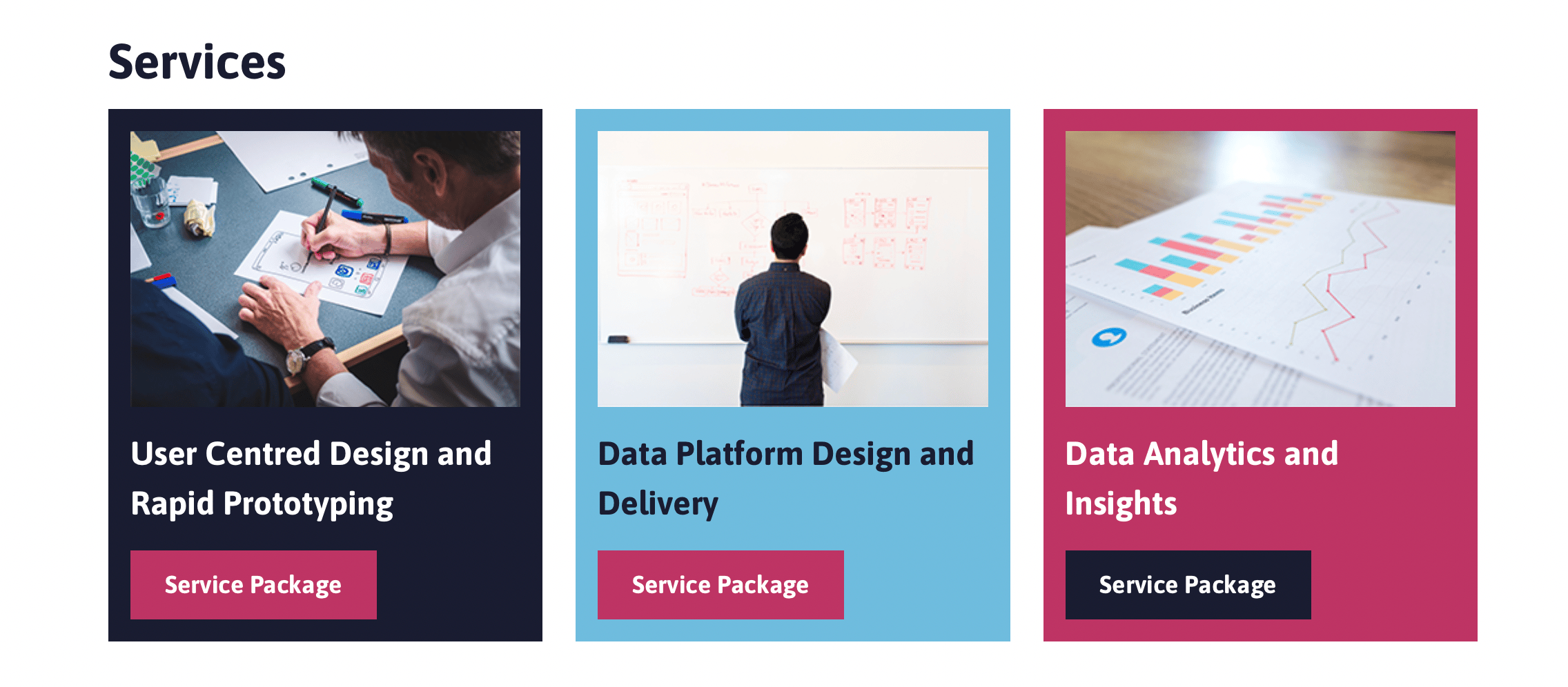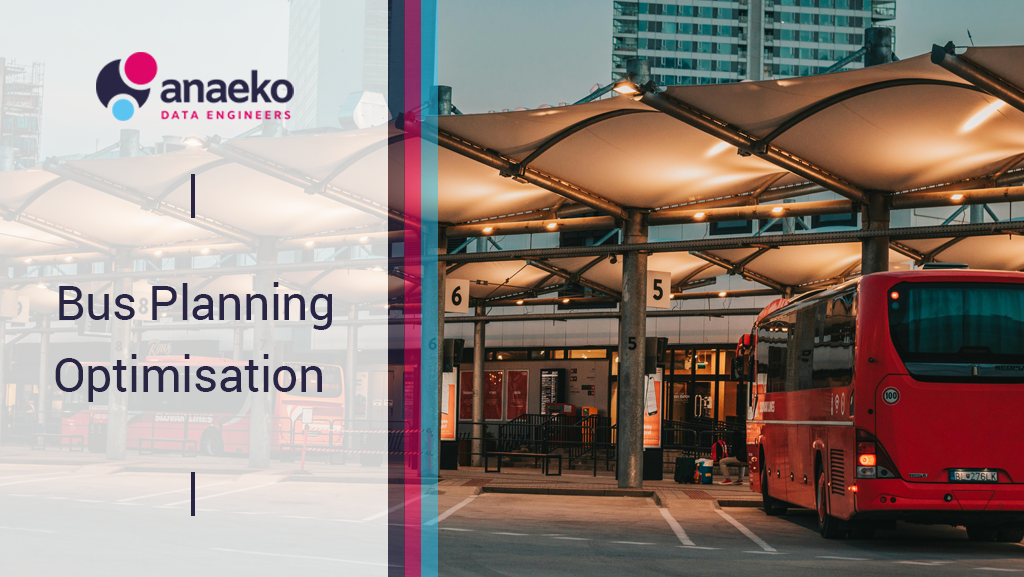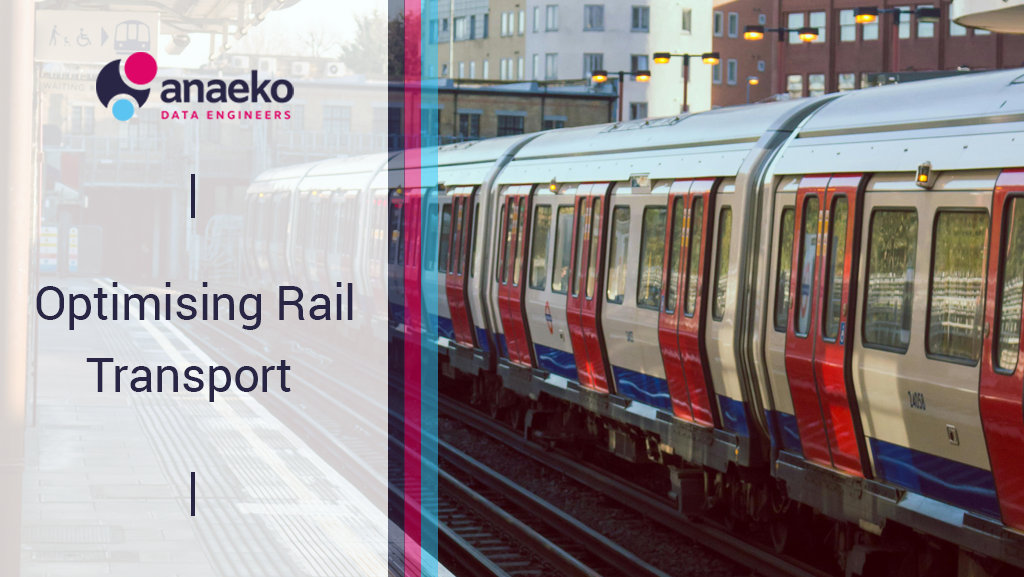Bus Éireann Vehicle Data Opportunities
Bus Éireann helps people all across the country make over 80 million journeys every year, as Ireland’s national bus company, their purpose is to connect people with who and what matters to them, helping to make life better.
Over 2,800 people make up the Bus Éireann with the values of safety and putting the customer first. They strive to provide a transport service of the highest possible standard with a focus on quality and safety.
During Anaeko's Optimising Transport Webinar we hear from Ken MacPherson, Head of Planning and Performance, at Bus Éireann discussing the opportunities and challenges Bus Éireann has in the goal to improve transport performance and sustainability.
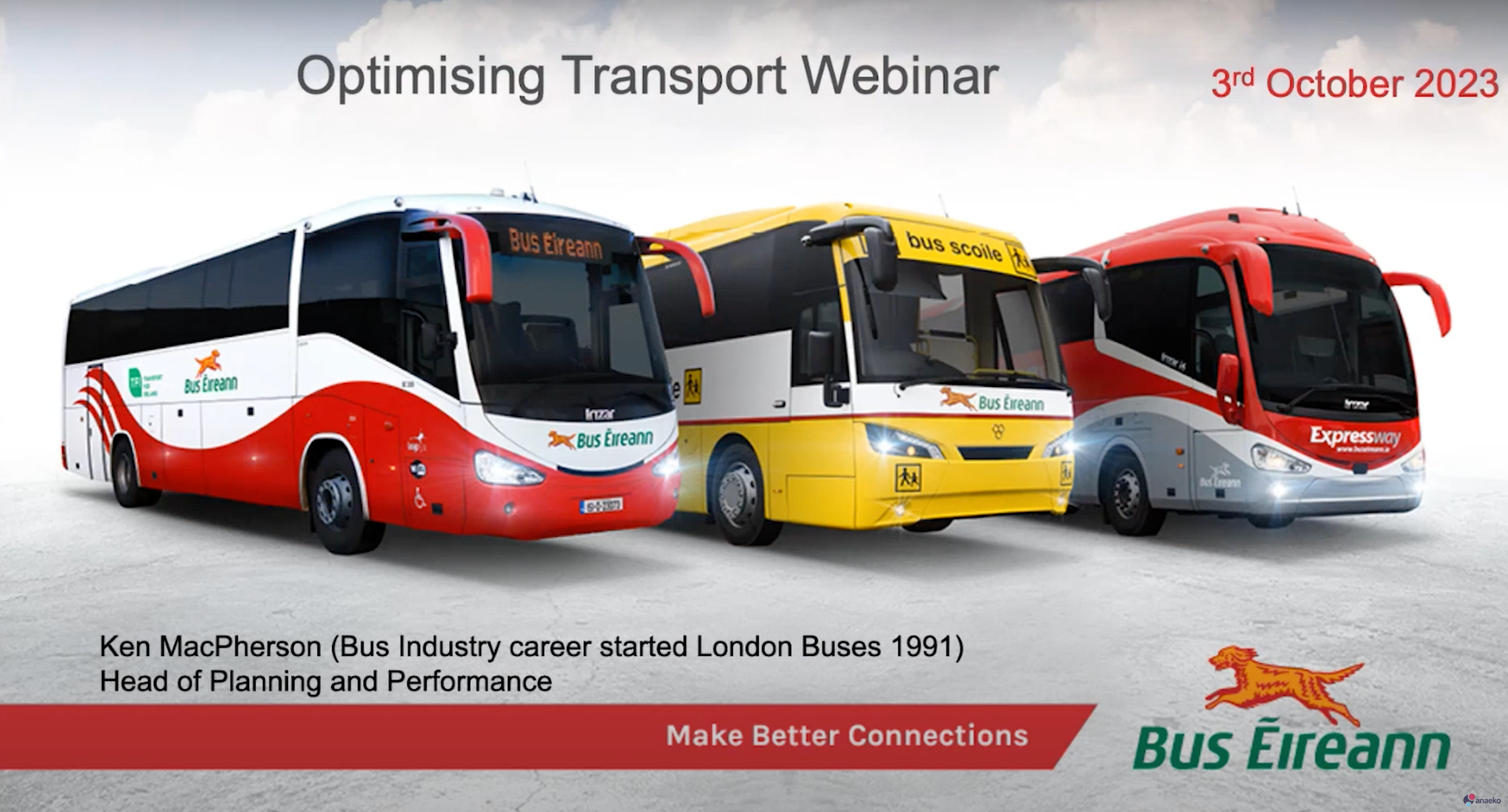
Let's look at some of the data opportunities that arise from our buses.
- We have an AVL tracking system on the bus, providing GPS data.
- Wi-Fi is available on the bus, which also gives us GPS data.
- Tachograph machines on the bus automatically upload data along with ticket machines.
- We use destination scrolls and telematics for monitoring both the vehicle engine and the driver's side of things.
- We also have a radio system in place. In essence, we have quite a wide array of data systems installed on all our vehicles.
Bus Éireann - The Vision
Our goal is to be the most customer-focused public transport company in Ireland. One of our key performance measures is punctuality and on-time services, which is essential for both our customers and stakeholders, including the National Transport Authority.
We aim for a punctuality rate of 90% at all bus stops, but contractual targets vary from 60% to 80%, with these targets increasing each contract year. To give you an idea of our scale, we manage over 220 timetables, operate 750 buses and coaches, employ nearly 2,000 drivers, and oversee 5,000+ bus stops. With such an extensive network, we deal with a multitude of data sets from various systems.
Our operations span the entire nation, and our environment is constantly changing. We faced congestion issues, followed by a lull in traffic conditions and customer numbers, which then surged, and road traffic patterns shifted. We saw more areas allocated to pedestrians and cyclists, creating additional congestion points. High congestion levels also increase the likelihood of incidents and collisions, further disrupting services. Additionally, we've witnessed a significant increase in customer numbers, driven by lower fare policies aimed at getting more young people to travel on buses.
These factors have led to increased loading times and challenges related to bus capacity. We're determined to use data to identify areas where we can make improvements. We have 13 main operating locations and several sub-depots, offering a range of services, from city and town services to inter-urban routes and expressway services.
Punctuality is measured rigorously, with strict guidelines to be no more than one minute early or 5 minutes and 59 seconds late at every bus stop in each direction. However, we've discovered that traffic patterns differ significantly between days of the week, with Mondays resembling Friday mornings and Friday pm showing the worst congestion.
This means that a one-size-fits-all timetable approach no longer works for weekdays. Sometimes we have too much or too little time allocated to certain sections of the timetable. This creates challenges, as customers don't want to wait too long at a bus stop, but we also need to meet our punctuality targets to avoid penalties for lateness.
Given these complexities, we're actively seeking opportunities to optimise our operations, enhance efficiency, and, most importantly, improve the experience for our customers.
Using Data to Create Value and Promote Sustainability
Let's delve into how Bus Éireann uses data to create value and promote sustainability. To get started, I looked into what data means on the internet, and I found a quote that says, "Data is a powerful tool for reviewing performance." For us, data represents a significant opportunity. We're inundated with data, and while people often use tools like Excel to extract, manipulate, and analyse it, the real key is having the right resources. These resources can be internal, system-based, or through partners we collaborate with to make sense of the data and gain useful insights.
One crucial lesson we've learned is the importance of understanding both the quantity and quality of our data. It's easy to make decisions based on a nice graph, but you must dig deeper to ensure you're working with a complete and accurate dataset. You need to ask if it represents the whole picture and whether it's been measured correctly. For instance, our data often shows buses departing early when they haven't. This can occur because cars park at bus stops, and when the bus moves forward after picking up passengers, the system mistakenly registers it as early departure. There are also geofencing issues to consider.
Our primary goal is to improve service delivery for our customers and establish efficient and effective operating plans. Efficiency is essential, but it's equally vital to be effective, especially in dealing with unexpected delays and challenges.
Now, let me touch on a couple of key initiatives. First, we've developed a Network Performance and Decisioning System to address the limitations of our existing Automatic Vehicle Location (AVL) system, which is nearing the end of its life. The Transport Authority is in the process of procuring a Next Generation AVL system, which all operators will eventually use. In the meantime, we're in a bit of a bind, as upgrading the current system is costly and not a wise investment for the short term. Thus, we sought a partner to create a system that enhances our insights into operations.
We're also actively looking for better planning tools because planning plays a pivotal role in bus operations. We're seeking a Timetable Optimiser that uses artificial intelligence to process AVL data, suggesting improvements and adjustments to our schedules. Additionally, we employ a Vehicle Optimiser that efficiently allocates vehicles based on capacity and time. We've also developed a Driver Duty Optimiser to ensure efficient and reliable driver schedules, and a Roster Optimiser that focuses on driver work-life balance, striving for shorter working days and more balanced rosters, even exploring options like four-day workweeks with three days off. These tools are essential for enhancing the overall efficiency and sustainability of our operations.
Network Performance and Decisioning System
Let's delve into our Network Performance and Decisioning System, a solution we pursued because our existing AVL system was nearing the end of its life. We needed a way to gain better insights and meet our contract compliance targets. The key objective when creating this system was integration - the ability to pull data from multiple systems. We operate with various systems, some of which already contain driver and vehicle planning data, while others only have specific vehicle identifiers. They don't necessarily link together.
Our goal was to bring all these data feeds together, particularly the ones with GPS tracking data, and combine them with ticketing systems and other relevant data sources. This integration would result in a more comprehensive and gap-free dataset, enabling us to gain a better understanding of our operations, which span across the country. Our service control centres are spread throughout the nation, and we need accurate insights to supervise and monitor our services remotely.
The Network Performance and Decisioning System has recently been implemented, and it has significantly enhanced the depth of our operational insights. We now have access to a broader range of real-time KPIs. We can track various aspects of our services, such as departure times in the morning, adherence to schedules, completion of trips, and arrival times back at the depot in the evening. We can also assess the performance of bus stops and routes, providing valuable insights into our services.
This system relies on the overlaying of multiple data feeds and compares them against our operating plans. It offers innovative representations of our data, providing excellent opportunities for improved planning and statistical reporting. Notably, it allows us to interact with our data, offering features like clicking on a timetable to view the actual trip, or clicking on a stop to access a map view of the bus, complete with GPS data and data source information.
However, the challenge lay in bringing together data from various systems, each with its unique vehicle identifiers. This required a complex process of linking and matching data sets through common denominators, including look-up tables and algorithms for handling competing data for the same location.
Despite these challenges, we successfully implemented the system, thanks to a capable partner. It has provided us with the ability to gain a comprehensive understanding of what's happening with our services across the country.
Timetable Optimiser Challenge
Now, let's discuss the challenges we face with the Timetable Optimiser. As mentioned earlier, we encounter various issues on the road, such as traffic congestion and increased passenger numbers. Conversely, we sometimes benefit from bus lanes that improve operating speeds on certain routes. Our operational landscape is ever-changing, so we need a tool to quickly determine if we have too much or too little time for each trip.
Consider that we have 226 timetables, each with two directions and variations for weekdays, Saturdays, and Sundays. When you multiply these factors together, it results in thousands of unique timetables to review. We needed an optimiser because much of this work was previously done manually, involving various data systems and manual adjustments in Excel or our planning system.
So, we turned to AI technology to analyse large volumes of historical data and suggest new timetables. We wanted a tool that could consider various variables and percentiles of late running to help us achieve specific punctuality targets, like 90% or 80%. However, there's a risk of putting in too much buffer time, leading to early running on quiet days, which can also be problematic. Striking the right balance is crucial.
We needed quicker and more accurate analysis of historical data and a comprehensive view of data inaccuracies, including false positives and other anomalies. Scrutinising data quality is essential, even with AI, and we'd closely examine any suggested changes that deviated significantly from the current plan.
We also required dynamic editing functionality because our services often need to meet at certain corridors at specific times, considering the frequency of services from different routes. This dynamic editing must be implemented without affecting rigid departure times. We also aimed to view standard deviation and percentile information to understand common trip overruns.
Lastly, we wanted to test the proposed timetables by comparing them with historical AVL data. This helped us gauge how effective the proposed timetables might have been in the past, even though it's not an exact science due to potential changes in driver behaviour.
The Timetable Optimiser is essential to help us adapt to the ever-changing operational environment and improve punctuality and efficiency.
Data = Opportunities
Now, let's delve into the opportunities that Bus Éireann has and what our next steps involve. Once again, it all comes back to the data.
We have a duty and roster optimising system that we're continually looking to improve. Our goal is to optimise the modelling to enhance driver efficiencies while also making the duties more attractive to drivers. In a market where driver availability is becoming scarcer, having driver-friendly schedules can be a significant competitive advantage for us.
Next, we have telematics systems that provide valuable data on vehicle performance and driver behaviour. With this system, we can monitor safety issues and provide drivers with an app that allows them to review their driving performance.
We've also introduced electric buses into our fleet. In fact, we're the first in Ireland to have fully electric town bus services. As we roll out more electric buses, we're dealing with entirely new data sets related to the vehicle's performance, range, kilowatt-hours, power consumption, and state of charge monitoring. Electric buses pose unique challenges, such as variable range depending on factors like weather, load factors, and topography. We need to plan routes to maximise vehicle usage while avoiding the risk of running out of battery power. This adds a new dimension to our planning, and the data opportunities are substantial.
Moreover, we're exploring alternative fuels for longer-distance vehicles, including hydrogen and other options. While there will be limitations and different considerations, we're eager to delve into this and anticipate numerous data opportunities that will arise.
Finally, we're transitioning to the next generation of ticketing systems in partnership with the Transport Authority. These new ticketing systems will provide us with much more detailed ticketing data, including GPS locations and load factor details. This data will help us plan our services according to demand and make more efficient decisions, such as choosing between single-decker and double-decker buses based on demand, thereby contributing to our environmental goals.
Bus Éireann is poised to take advantage of various data-driven opportunities to enhance our operations and prepare for the future.
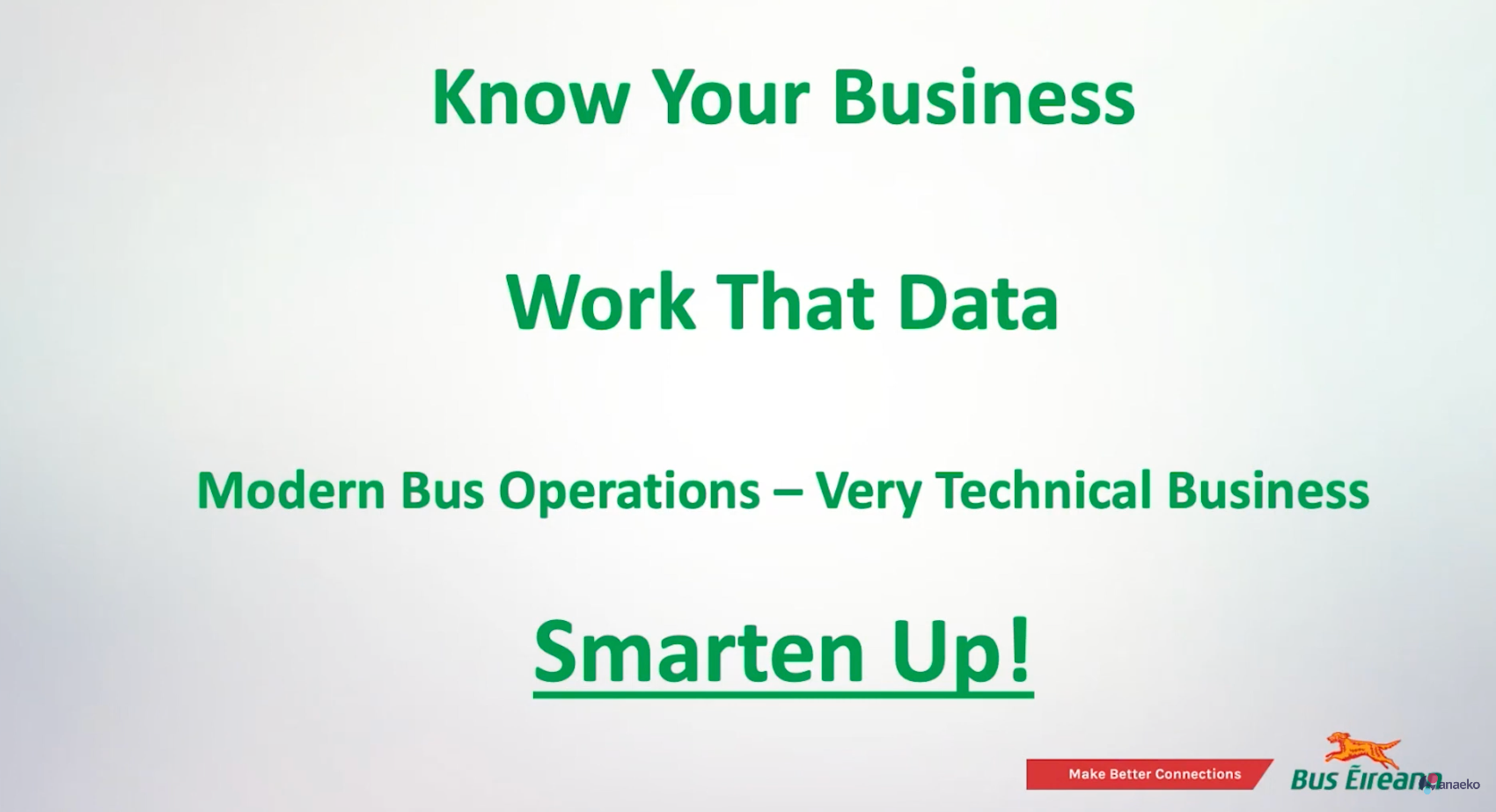
Conclusion
We truly need to understand our business, to get hands-on and operate it effectively. However, we must adapt and learn how to work with our data. Having various systems and datasets is fantastic, but they need to communicate with each other. It's not helpful when you're inundated with different pieces of data, and there's no coherent narrative. Consolidating all of this data into a single, coherent story is quite remarkable. We are starting to witness this transformation with our NPDS system.
The modern bus operation is now an exceedingly technical business. When I first began working in central operations at Bus Éireann, I could foresee the direction things were heading. Recognising my limited technical knowledge, I quickly understood the need to collaborate with IT experts. This way, I could share my operational expertise with them while they guided me through the complex and ever-evolving world of technology.
In summary, our journey through Bus Éireann data, and our ongoing efforts to maximise its potential is about adapting to a technical and data-rich environment to deliver the best service possible.
About Anaeko
Anaeko is a data engineering company. We have been in operation since 2004, delivering over 500 cloud and data projects in the areas of data and Cloud Consulting. This involves advising and providing solutions, and teams, where we offer specialised data engineering skills to support in-house or multi-supplier delivery.
Our primary focus is to help our customers and partners build and operate data analytics platforms. We pride ourselves on being a highly collaborative company, aiming to be the go-to collaboration partner for building and managing these platforms, including data pipelines.
Topics: Open Data, Digital Transformation, Data, transport, sustainability

